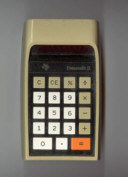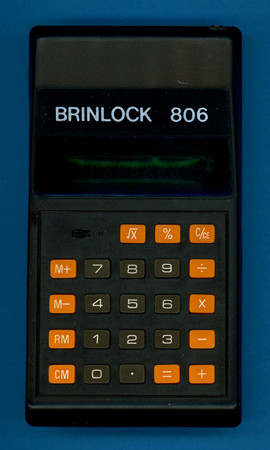
DATAMATH CALCULATOR MUSEUM
 |
DATAMATH CALCULATOR MUSEUM |
Model 806
| Date of introduction: | 1980 | Display technology: | Fluorescent |
| New price: | Display size: | 8 | |
| Size: | 5.4" x 3.0 x 1.00" 136 x 76 x 25 mm3 |
||
| Weight: | 3.6 ounces, 102 grams | Serial No: | 026912 |
| Batteries: | 2*AA | Date of manufacture: | mth 06 year 1980 |
| AC-Adapter: | Origin of manufacture: | Hong Kong | |
| Precision: | 8 | Integrated circuits: | TMS1044 (MT 8018) |
| Memories: | Displays: | Futaba 9-ST-11 | |
| Program steps: | Courtesy of: | Joerg Woerner |

![]()
 Brinlock Ltd of Caversham, Reading was a British marketing company importing in the 1970s and early 1980s electronic calculators from Far East.
This Model 806 caught our attention in 2023 while researching Texas Instruments'
TMS1040 Product family of "single-chip calculator circuits" and
noticing its interesting keyboard with only 23 keys.
Brinlock Ltd of Caversham, Reading was a British marketing company importing in the 1970s and early 1980s electronic calculators from Far East.
This Model 806 caught our attention in 2023 while researching Texas Instruments'
TMS1040 Product family of "single-chip calculator circuits" and
noticing its interesting keyboard with only 23 keys.


 Dismantling
this Brinlock Model 806 manufactured in June 1980 in Hong Kong reveals a very
cost effective design using a single-sided printed circuit board (PCB) centered
around a TMS1044 single-chip calculator
circuit connected to a 9-digit Vacuum Fluorescent Display (VFD), a keyboard
assembly and powered by 2 AA-sized alkaline batteries.
Dismantling
this Brinlock Model 806 manufactured in June 1980 in Hong Kong reveals a very
cost effective design using a single-sided printed circuit board (PCB) centered
around a TMS1044 single-chip calculator
circuit connected to a 9-digit Vacuum Fluorescent Display (VFD), a keyboard
assembly and powered by 2 AA-sized alkaline batteries.
![]()
 The TMS1044 is a member of the
TMS1040 Product Family based on the
TMS1070
"computer-on-a-chip" introduced in 1974 with the original
TMS1000.
While the TMS1070 can directly interface with low-voltage VFDs up to 35 Volts
does it still need external resistors and a zener diode to bias the anodes and
grids of the display with respect to the filament. The TMS1040 added an extra
VPP pin to connect a negative 30 Volts bias voltage for its modified
output drivers. With the TMS1070 featuring 11 R Outputs for the Digits, 8 O
Outputs for the Segments and 4 K Inputs for the Keyboard, reduced the TMS1040
the number of R Outputs to 9, consequently are all known TMS1040 calculator
designs using a 9-digit VF Display.
The TMS1044 is a member of the
TMS1040 Product Family based on the
TMS1070
"computer-on-a-chip" introduced in 1974 with the original
TMS1000.
While the TMS1070 can directly interface with low-voltage VFDs up to 35 Volts
does it still need external resistors and a zener diode to bias the anodes and
grids of the display with respect to the filament. The TMS1040 added an extra
VPP pin to connect a negative 30 Volts bias voltage for its modified
output drivers. With the TMS1070 featuring 11 R Outputs for the Digits, 8 O
Outputs for the Segments and 4 K Inputs for the Keyboard, reduced the TMS1040
the number of R Outputs to 9, consequently are all known TMS1040 calculator
designs using a 9-digit VF Display.

 Looking
closer onto the PCB you'll notice two diodes placed
somehow between the TMS1044 and the keyboard assembly - at first glance an unusual
approach. Preparing our DCM-50A Platform
to allow the Characterization of Single-Chip Calculator Circuits
of the TMS1040 Family, we reverse-engineered the Model 806 calculator and
understood that Texas Instruments started to add with the TMS1040 a "virtual"
5th Keyboard Input line by using two additional diodes emulating the 5 K Inputs
of the TMC0980 Family. While the
TMS0100 single-chip calculator circuit
introduced the concept of an 11x4 keyboard matrix scanned with the 11 Digit
Outputs and 4 Keyboard Inputs, would the reduction to just 9 Digit Outputs of
the TMS1040 allow for only 9x4 keys and switches, in some calculator
applications a possible show-stopper. Adding an extra "virtual" Keyboard Input
allows consequently for a 9x5 keyboard matrix - but the featured Brinlock Model
806 sports obviously only 23 keys and an hard-wired power [on/off] switch. The
TMS1044 was used with a wide range of calculators, this Model 806 and the Bohsei
Model 1000 with 25 keys marked the
lower end, while the Privileg 858 MD
unleashed the potential of the chip with 31 keys and an additional sliding
switch and the Unisonic Model 1040-1
being the middle child with its 27 keys.
Looking
closer onto the PCB you'll notice two diodes placed
somehow between the TMS1044 and the keyboard assembly - at first glance an unusual
approach. Preparing our DCM-50A Platform
to allow the Characterization of Single-Chip Calculator Circuits
of the TMS1040 Family, we reverse-engineered the Model 806 calculator and
understood that Texas Instruments started to add with the TMS1040 a "virtual"
5th Keyboard Input line by using two additional diodes emulating the 5 K Inputs
of the TMC0980 Family. While the
TMS0100 single-chip calculator circuit
introduced the concept of an 11x4 keyboard matrix scanned with the 11 Digit
Outputs and 4 Keyboard Inputs, would the reduction to just 9 Digit Outputs of
the TMS1040 allow for only 9x4 keys and switches, in some calculator
applications a possible show-stopper. Adding an extra "virtual" Keyboard Input
allows consequently for a 9x5 keyboard matrix - but the featured Brinlock Model
806 sports obviously only 23 keys and an hard-wired power [on/off] switch. The
TMS1044 was used with a wide range of calculators, this Model 806 and the Bohsei
Model 1000 with 25 keys marked the
lower end, while the Privileg 858 MD
unleashed the potential of the chip with 31 keys and an additional sliding
switch and the Unisonic Model 1040-1
being the middle child with its 27 keys.
Comparing the functionality of these calculators demonstrates the bandwidth of products made possible with the TMS1044 single-chip calculator circuit:
| Calculator | C CE |
C/CE | M+ M− |
RM CM |
R/CM | X<>M | X<>Y | +/- | 1/x | x2 | √x | % | Δ% | PI | → | ∑ |
| Brinlock Model 806 | * | * | * | * | * | |||||||||||
| Bohsei Model 1000 | * | * | * | * | * | * | * | * | ||||||||
| Unisonic Model 1040-1 | * | * | * | * | * | * | * | * | ||||||||
| Privileg 858 MD | * | * | * | * | * | * | * | * | * | * | * | * | * | * |
The Canon F-31 using with the
TMS1045 another product of the TMS1040 portfolio sports 30 keys and a 4-position
switch and hence making good use of the "virtual" 5th
Keyboard Input line.
If you have additions to the above article please email: joerg@datamath.org.
© Joerg Woerner, February 8, 2023. No reprints without written permission.